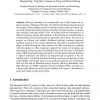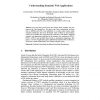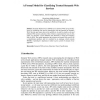ASWC
2008
Springer
14 years 8 months ago
2008
Springer
ASWC
2008
Springer
14 years 8 months ago
2008
Springer
Ontology matching is a promising step towards the solution to the interoperability problem of the Semantic Web. Instance-based methods have the advantage of focusing on the most ac...
ASWC
2008
Springer
14 years 8 months ago
2008
Springer
Information sharing can be effective with structured data. However, there are several challenges for having structured data on the web. Creating structured concept definitions is ...
ASWC
2008
Springer
14 years 8 months ago
2008
Springer
Abstract. Ontology reasoning is an indispensable step to fully exploit the implicit semantics of Semantic Web data. The inherent distribution characteristic of the Semantic Web and...
ASWC
2008
Springer
14 years 8 months ago
2008
Springer
ASWC
2008
Springer
14 years 8 months ago
2008
Springer
Abstract. Enabling a system to automatically conceptualize and annotate a human-readable table is one way to create interesting semanticweb content. But exactly "how?" is...
ASWC
2008
Springer
14 years 8 months ago
2008
Springer
Ten years have passed since the concept of the semantic web was proposed by Tim Berners-Lee. For these years, basic technologies for them such as RDF(S) and OWL were published. As ...
ASWC
2008
Springer
14 years 8 months ago
2008
Springer
Today's knowledge workers have to spend a large amount of time and manual effort on creating, analyzing, and modifying textual content. While more advanced semantically-orient...
ASWC
2008
Springer
14 years 8 months ago
2008
Springer
Abstract. Semantic Web Services (SWS) aim to alleviate Web service limitations, by combining Web service technologies with the potential of Semantic Web. Several open issues have t...
ASWC
2008
Springer
14 years 8 months ago
2008
Springer
Both semantic web applications and individuals are in need of knowledge infrastructures that can be used in dynamic and distributed environments where different autonomous entities...



